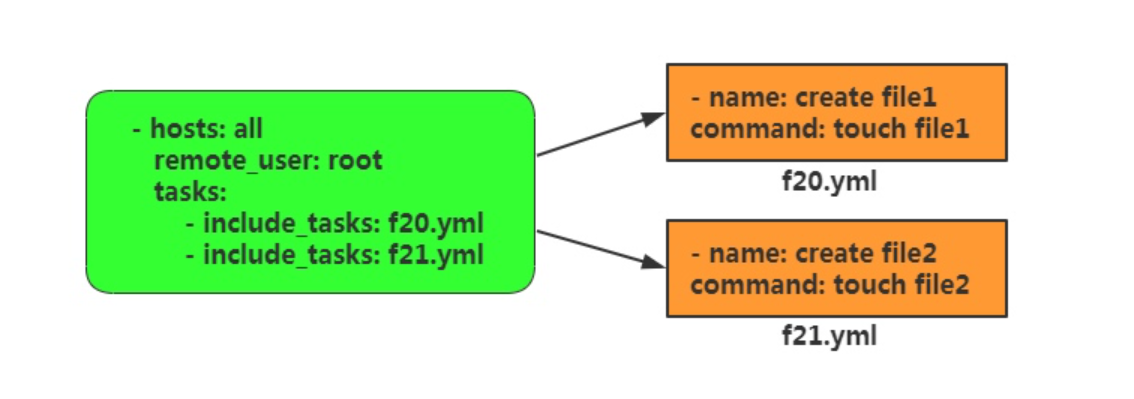Ansible 流程控制
Ansible 流程控制
一、playbook 条件语句
# 不管是shell还是各大编程语言中,流程控制,条件判断这些都是必不可少的,在我们使用Ansible的过程中,条件判断的使用频率极其高。
例如:
1.我们使用不同的系统的时候,可以通过判断系统来对软件包进行安装。
2.在nfs和rsync安装过程中,客户端服务器不需要推送配置文件,之前我们都是写多个play,会影响效率。
3.我们在源码安装nginx的时候,执行第二遍就无法执行了,此时我们就可以进行判断是否安装过。
1.判断系统
[root@m01 project]# vim xitong.yml
- hosts: web_group
tasks:
- name: Install Centos httpd
shell: "yum install -y httpd"
when: ansible_distribution == "CentOS"
- name: Install Ubuntu httpd
shell: "apt-get apache2"
when: ansible_distribution == "Ubuntu"
2.判断主机
[root@m01 project]# cat base.yml
- name: Create www Group
group:
name: www
gid: 666
state: present
when: ansible_fqdn != "db01"
- name: Create www User
user:
name: www
uid: 666
group: www
shell: /sbin/nologin
create_home: false
state: present
when: ansible_fqdn != "db01"
3.判断服务是否安装
[root@m01 project]# cat php.yml
- hosts: web_group
tasks:
- name: Tar php Package
unarchive:
src: /project/package/php.tar.gz
dest: /tmp/
#使用shell模块,检查php是否安装,将结果赋值给注册的变量
- name: Check php Install Status
shell: "rpm -qa | grep php | wc -l"
register: get_php_instll_status
#调用注册的变量,当变量中stdout_lines为0的时候,才会安装php
- name: Install php Server
shell: "yum localinstall -y /tmp/*.rpm"
when: get_php_instll_status.stdout_lines == 0
4.判断系统版本启动服务
1)写法一:使用列表的形式
[root@m01 project]# vim startserver.yml
- hosts: web_group
tasks:
- name: Start CentOS 6 Server
shell: "/etc/init.d/httpd start"
when:
- ansible_distribution == "CentOS"
- ansible_distribution_major_version == "6"
- name: Start CentOS 7 Server
shell: "systemctl start httpd"
when:
- ansible_distribution == "CentOS"
- ansible_distribution_major_version == "7"
2)写法二:多条件and连接
[root@m01 project]# vim startserver.yml
- hosts: web_group
tasks:
- name: Start CentOS 6 Server
shell: "/etc/init.d/httpd start"
when: (ansible_distribution == "CentOS") and (ansible_distribution_major_version == "6")
- name: Start CentOS 7 Server
shell: "systemctl start httpd"
when: (ansible_distribution == "CentOS") and (ansible_distribution_major_version == "7")
5.判断服务是否启动
- hosts: web_group
tasks:
- name: Check Httpd Server
command: systemctl is-active httpd
ignore_errors: yes
register: check_httpd
- name: debug outprint
debug: var=check_httpd
- name: Httpd Restart
service:
name: httpd
state: restarted
when: check_httpd.rc == 0
二、playbook 循环语句
在之前的学习过程中,我们经常会有传送文件,创建目录之类的操作,创建2个目录就要写两个file模块来创建,如果要创建100个目录,我们需要写100个file模块???妈耶~~~~ 当然不是,只要有循环即可,减少重复性代码。
1.定义循环安装服务
[root@m01 project]# vim yum.yml
- hosts: web_group
gather_facts: no
tasks:
- name: Install Redis Server
yum:
name: "{{ package }}"
state: present
vars:
package:
- redis
- httpd
2.定义循环启动服务
#错误写法
[root@m01 project]# vim start.yml
- hosts: web_group
tasks:
- name: Start Server
systemd:
name: "{{ package }}"
state: started
vars:
package:
- redis
- httpd
#正确写法
[root@m01 project]# vim start.yml
- hosts: web_group
tasks:
- name: Start Server
systemd:
name: "{{ item }}"
state: started
with_items:
- redis
- httpd
3.字典定义变量
[root@m01 project]# cat user.yml
- hosts: lb01
tasks:
- name: Create Some Group
group:
name: "{{ item.name }}"
gid: "{{ item.gid }}"
state: present
with_items:
- { name: "lhd", gid: "777" }
- { name: "test", gid: "888" }
- { name: "egon", gid: "999" }
- name: Create Some User
user:
name: "{{ item.name }}"
uid: "{{ item.uid }}"
group: "{{ item.group }}"
shell: "{{ item.shell }}"
create_home: "{{ item.create_home }}"
with_items:
- { name: "lhd", uid: "777", group: "lhd", shell: "/sbin/nologin", create_home: "false" }
- { name: "test", uid: "888", group: "test", shell: "/bin/bash", create_home: "false" }
- { name: "egon", uid: "999", group: "egon", shell: "/bin/bash", create_home: "true" }
三、playbook handlers 触发器
1.什么是handlers?
# handler用来执行某些条件下的任务,比如当配置文件发生变化的时候,通过notify触发handler去重启服务。
# 在saltstack中也有类似的触发器,写法相对Ansible简单,只需要watch,配置文件即可。
2.配置触发器
[root@m01 project]# cat nginx.yml
- hosts: nginx
tasks:
- name: Config Nginx Server
copy:
src: /etc/nginx/nginx.conf
dest: /etc/nginx/
notify: restart_nginx
- name: Start Nginx Server
systemd:
name: nginx
state: started
handlers:
- name: restart_nginx
systemd:
name: nginx
state: restarted
3.触发器使用注意事项
# 1.无论多少个task通知了相同的handlers,handlers仅会在所有tasks结束后运行一次。
# 2.Handlers只有在其所在的任务被执行时,才会被运行;如果一个任务中定义了notify调用Handlers,但是由于条件判断等原因,该任务未被执行,那么Handlers同样不会被执行。
# 3.Handlers只会在每一个play的末尾运行一次;如果想在一个playbook中间运行Handlers,则需要使用meta模块来实现。例如: -meta: flush_handlers。
# 4.如果一个play在运行到调用Handlers的语句之前失败了,那么这个Handlers将不会被执行。我们可以使用meta模块的--force-handlers选项来强制执行Handlers,即使Handlers所在的play中途运行失败也能执行。
# 5.不能使用handlers替代tasks
4.简单优化后的php文件
[root@m01 project]# cat php.yml
- hosts: web_group
tasks:
- name: Tar php Package
unarchive:
src: /project/package/php.tar.gz
dest: /tmp/
- name: Check php Install Status
shell: "rpm -qa | grep php | wc -l"
register: get_php_instll_status
- name: Install php Server
shell: "yum localinstall -y /tmp/*.rpm"
when: get_php_instll_status.stdout_lines == 0
- name: Config php Server
copy:
src: "{{ item.src }}"
dest: "{{ item.dest }}"
with_items:
- { src: "/project/conf/php.ini", dest: "/etc" }
- { src: "/project/conf/www.conf", dest: "/etc/php-fpm.d/" }
notify: restart_php
- name: Start php Server
systemd:
name: php-fpm
state: started
handlers:
- name: restart_php
systemd:
name: php-fpm
state: restarted
四、playbook 任务标签
1.标签的作用
默认情况下,Ansible在执行一个playbook时,会执行playbook中定义的所有任务,Ansible的标签(tag)功能可以给单独任务甚至整个playbook打上标签,然后利用这些标签来指定要运行playbook中的个别任务,或不执行指定的任务。
2.打标签的方式
# 1.对一个task打一个标签
# 2.对一个task打多个标签
# 3.对多个task打一个标签
3.对一个task打一个标签
- hosts: nginx
- name: Config Nginx Server
copy:
src: /etc/nginx/nginx.conf
dest: /etc/nginx/
notify: restart_nginx
tags: reconf_nginx
4.对多个task打一个标签
- hosts: nginx
- name: Config Nginx Server
copy:
src: /etc/nginx/nginx.conf
dest: /etc/nginx/
notify: restart_nginx
tags: reconf_nginx
- name: Config Nginx wordpress
copy:
src: /project/conf/linux.wp.com.conf
dest: /etc/nginx/conf.d/
notify: reload_nginx
when: (ansible_fqdn == "web01") or (ansible_fqdn == "web02")
tags: reconf_nginx
5.对一个task打多个标签
- hosts: nginx
- name: Config Nginx Server
copy:
src: /etc/nginx/nginx.conf
dest: /etc/nginx/
notify: restart_nginx
tags:
- reconf_nginx
- reconfig_nginx
6.标签使用方式
1)查看标签
[root@m01 project]# ansible-playbook wp.yml --list-tags
playbook: wp.yml
play #1 (nginx): nginx TAGS: []
TASK TAGS: [reconf_nginx, reconfig_nginx]
2)执行指定标签的内容
[root@m01 project]# ansible-playbook wp.yml -t reconfig_nginx
3)执行多个标签代表的内容
[root@m01 project]# ansible-playbook wp.yml -t reconf_nginx,reconfig_nginx
4)不执行指定标签的内容
[root@m01 project]# ansible-playbook wp.yml --skip-tags reconfig_nginx
五、playbook 复用
在之前写playbook的过程中,我们发现,写多个playbook没有办法,一键执行,这样我们还要单个playbook挨个去执行,很鸡肋。所以在playbook中有一个功能,叫做include用来动态调用task任务列表。

只调用task:include_tasks
调用整个task文件:include (新版本:import_playbook)
在saltstack中,叫做top file入口文件。
1.playbook复用的配置
1)编辑两个剧本
[root@m01 project]# cat play1.yml
- name: Install Nginx Server
yum:
name: nginx
state: present
[root@m01 project]# cat play2.yml
- name: Config Nginx Server
copy:
src: /etc/nginx/nginx.conf
dest: /etc/nginx/
2)编写复用剧本的文件
[root@m01 project]# vim main.yml
- hosts: web_group
tasks:
- include_tasks: /project/play1.yml
- include_tasks: /project/play2.yml
2.直接复用palybook文件
[root@m01 project]# cat main.yml
- import_playbook: ./base.yml
- import_playbook: ./nginx.yml
- import_playbook: ./php.yml
- import_playbook: ./wordpress.yml
- import_playbook: ./mariadb.yml
2、playbook忽略错误
默认playbook会检测task执行的返回状态,如果遇到错误则会立即终止playbook的后续task执行,然鹅有些时候playbook即使执行错误了也要让其继续执行。
- hosts: web_group
tasks:
- name: Check Httpd Server
#使用命令检查服务启动状态时,如果服务没有启动则会得到错误结果,剧本会停止运行
command: systemctl is-active httpd
#配置忽略错误可以继续执行剧本
ignore_errors: yes
register: check_httpd
- name: debug outprint
debug:
msg: "{{ check_httpd }}"
- name: Httpd Restart
service:
name: httpd
state: restarted
when: check_httpd.rc == 0
3、错误处理
# 如上所述,当task执行失败时,playbook将不再继续执行,包括如果在task中设置了handler也不会被执行。
#但是我们可以采取强制措施...
1)强制调用handlers
[root@m01 ~]# cat handler.yml
- hosts: web_group
vars:
- http_port: 8080
force_handlers: yes
tasks:
- name: config httpd server
template:
src: ./httpd.j2
dest: /etc/httpd/conf
notify:
- Restart Httpd Server
- Restart PHP Server
- name: Install Http Server
yum:
name: htttpd
state: present
- name: start httpd server
service:
name:httpd
state: started
enabled: yes
handlers:
- name: Restart Httpd Server
systemd:
name: httpd
state: restarted
- name: Restart PHP Server
systemd:
name: php-fpm
state: restarted
2)抑制changed
# 被管理主机没有发生变化,可以使用参数将change状态改为ok
- name: Check php Install Status
shell: "rpm -qa | grep php | wc -l"
register: get_php_instll_status
changed_when: false

